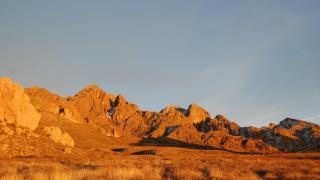Reflections from the 2025 Fall Retreat
The People, Groups, and Ideas Making Change
Thank you to those who joined us at the 2025 Fall Retreat in Santa Ana Pueblo, New Mexico! Nearly three hundred of you gathered to advance the next phase of work for people and planet.
In New Mexico, we confronted the real-time limitations of aging systems that, by design or decision, are failing to meet the collective need.
Divestment decisions to limit critical federal programs, enhanced and intentional use of military force, and campaigns to separate families with accompanying narratives of othering and inhumanity are reshaping the terms of our union. This shifting reality has created material scarcity for an increasing number of vulnerable people. We gathered with this context in the lands of the Tamaya, with respect to its Indigenous leadership, to interrogate the moment and commit to renewed daily action for sectoral alignment.
The Retreat offered many opportunities to reflect on our shared humanity, and the hope that we represent to one another for more than survival. It is inspiring to learn from and with you, to cultivate the strength of our practice and our presence, to remember our collective capacity to renew, and to restore in ways that positively undergird movements with dynamic resources.
Together, we do, we can, and we will continue to establish new practices and offer restoration for the weathered practice of democracy as a function of our crusade for a sustainable Earth home. Along with the concurrent sessions, the powerful plenaries, and the ongoing investment in each other, the Retreat’s Santa Ana Sessions (SAS) are a testament to our collective ability to be critical lovers of our work, for the generations.
At the daily convenings of the Santa Ana Sessions, we gathered by the dozen over three days. We turned our questions and comments into commitments from philanthropy. These commitments work towards strategic visibility in this moment as an answer to claims of violent silence from the sector.
The resulting working document, the Santa Ana Accords on the Future of Environmental Philanthropy, is your invitation to clarify our values as a sector and position your work as a grantmaker in alignment with mission. You are heartily invited to review the Accords, and share your thoughts, support, or needs as we move to the next phase of this work. (As this is a working document, member login is required.)
I encourage you to invest some time in reviewing this recap and resource guide as a gift from your peers. The resulting action plan includes profiles, ideas, and information from the people and organizations that are shifting the narrative, creating solutions, and mutually reinforcing people for the planet.
In community,
Tamara
Tamara Toles O'Laughlin
CEO and President
Environmental Grantmakers Association
Launch of the The Santa Ana Accords on the Future of Environmental Philanthropy
The 2025 Fall Retreat in Santa Ana Pueblo marked the next chapter for environmental philanthropy. Over the course of three days at the Retreat, EGA members and philanthropic leaders gathered for the Santa Ana Sessions (SAS). The SAS was a series of strategic sessions where grantmakers collaborated to outline and shape our collective vision of the future of philanthropy.
On the last day of the Retreat, the results of the SAS culminated into the Santa Ana Accords on the Future of Environmental Philanthropy.
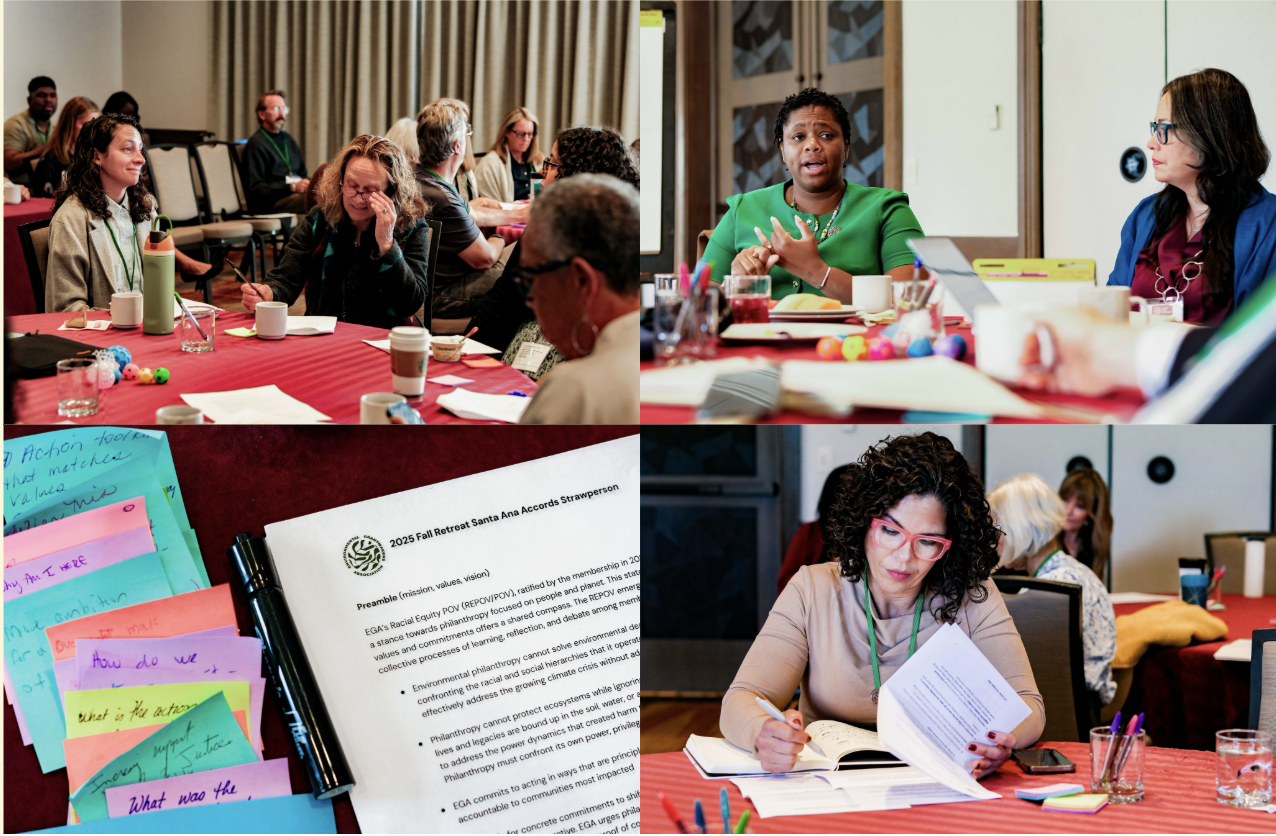
The Accords build directly from the member-mandated Racial Equity POV. The current working draft aims to shift from framework to action by setting the baseline for our present context and making commitments that will help us move forward to address challenges.
We invite you to read the Accords in our new member-only resource library. (Login is required, if you need assistance setting up your member login, please reach out to Celia Bottger, Membership Manager.)
Opening Session: Honoring Place, History and Hope
EGA convened the 2025 Retreat on the lands of the Tamayame, also known as Santa Ana Pueblo, New Mexico. Local leaders, Andrea Serrano, Executive Director of OLÉ (Organizers in the Land of Enchantment) and Camilla Bustamante, Santa Fe County Commissioner, opened our gathering by sharing the cultural and historical context of the region. This conversation was moderated by Louis Gordon, EGA Board Vice Chair and Program Director at the Seventh Generation Fund for Indigenous Peoples.
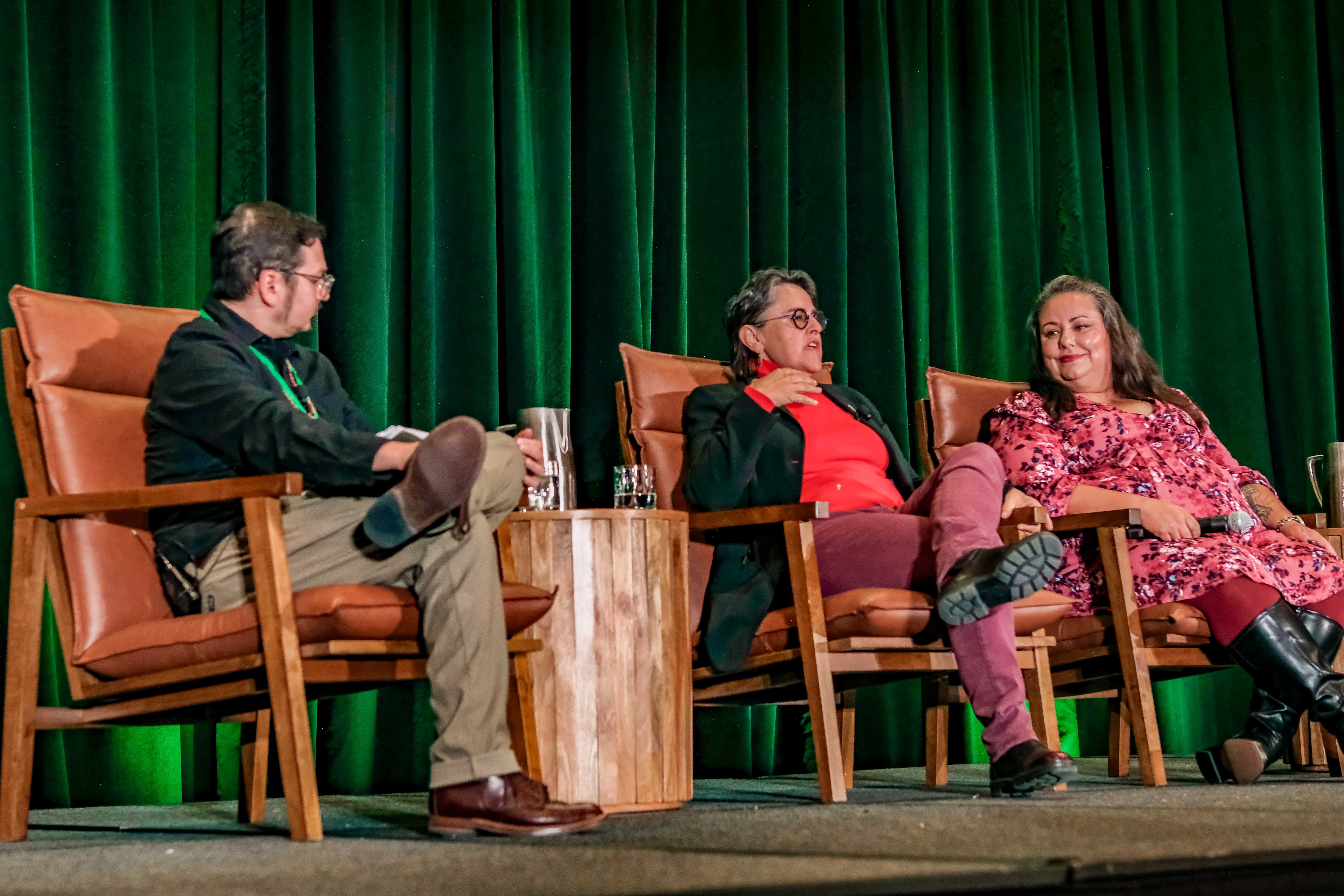
[From left to right: Louis Gordon, EGA Board Vice Chair and Program Director at the Seventh Generation Fund for Indigenous Peoples, Camilla Bustamante, Santa Fe County Commissioner and Andrea Serrano, Executive Director of OLÉ (Organizers in the Land of Enchantment)]
New Mexico has been in a constant cycle of colonization, from when settlers first arrived to the present. In 1945, nuclear testing at White Sands disproportionately affected the Tribes of the region, and these tests and associated uranium mining continue to have generational impacts.
New Mexico is also the second-largest crude oil producer after Texas in the United States. Despite decades of challenges from the extraction of ecosystems and stolen land, Indigenous and local organizers continue to take on powerful interests for a healthy and sustainable economy. Currently, communities are working towards divesting the state from oil and gas.
Takeaways
- Generational stewardship and wisdom has kept New Mexico alive. The original people of the land continue to steward the environment and pass down knowledge and culture. It’s crucial to support leaders with lived experience. In the last fifteen years, there has been an increase in organizations supporting members of frontline communities in finding new careers, especially as policymakers.
- Invest in Organizing: Community organizing creates the conditions for policy to move forward. Ramping up investments in organizing with the leadership of women, Indigenous people, and nonbinary/queer individuals can help New Mexico grow its economy beyond oil and gas.
Further reading:
- Tewa Women United (TWU): Tewa Women United works to embody courageous spaces that center Indigenous women and girls to connect with ancestral knowingness, healing strengths, and lifeways for the wellbeing of all.
- “Generations after Trinity Test, New Mexico downwinders seek compensation” NPR
- “What Is a Downwinder?” Huntsman Cancer Institute
"Querencia: Living with the empathy and understanding of who and where you are." -Camilla Bustamante, Santa Fe County Commissioner
The Path to Revitalized Democracy
Opening Keynote
Saqib Bhatti, co-founder and Executive Director of the Action Center on Race and the Economy (ACRE) delivered a powerful keynote that set the context on the state of today’s democracy. Saqib offered a critical power analysis and strategies for grantmakers to support a path forward for a just democracy.
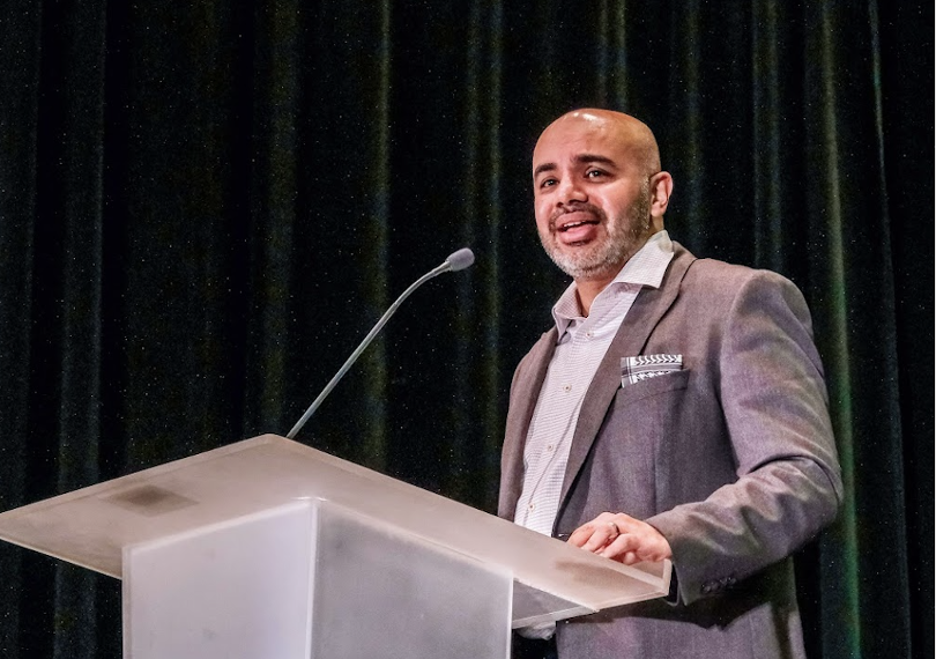
Saquid Bhatti, co-founder and Executive Director of the Action Center on Race and the Economy (ACRE)
Takeaways
- Adopt a deep power analysis: As communities are under siege, who holds power to improve the conditions? And who can influence the decision-makers? How do we reach these influential people and also challenge their power? By integrating a deep power analysis of our current context into our strategies, we can tackle the root of our challenges and effectively respond to immediate needs.
- Increase grantmaking to people-powered movements, narrative change, and rapid response: Go deep into endowments, beyond 1%-15%, to resource groups that can directly support their communities in a time of peril. Resource movements which can shift the balance of power to the people in the long haul and rewrite the toxic narratives about communities.
- Fund base and power building: Every major organizing network has laid off organizers this year. Resourcing racial equity, worker power, and base building will strengthen our democracy by advancing multiracial class solidarity.
- Demand corporate accountability by divesting from Big Tech: Divest assets from the tech billionaires and corporations who are currently profiting from ecosystem destruction, family separation, war, and other atrocities.
- Be flexible with your strategies: Adapt your organizational decision making structures to this moment. What’s needed most is funding, not strategic planning. Foundations must democratize their money and empower communities to decide where the money goes.
Give truth to the narrative: We need to have crucial discussions about race in a way that people will understand and build relationships. We must help people understand that what unites us is leaps and bounds greater than what divides us.
[Read] “Transcending Racial Capitalism—A Conversation with Steve Dubb, Rithika Ramamurthy, and Saqib Bhatti”
AI & the Future of Philanthropy: Risk, Responsibility and the Fight for People and Planet
We invited Linda Saleh of Building Equity and Alignment (BEA) Fund, Tareq Alani of Chorus AI, Michel Gelobter of the Yale Center for Environmental Justice (YCEJ), and Catherine Bracy of Tech Equity, for a discussion focused on the challenges and opportunities of AI usage in the philanthropic sector.
AI has existed for a long time. What’s new is Generative AI.
It’s necessary to differentiate between AI and generative AI. AI includes everything from automation to machine learning, which has existed for a long time. Generative AI, such as ChatGPT and similar large language models, is the new technology most of us are concerned about. Generative AI is already affecting frontline communities with the surge of data centers and non-regulation of the technology.
Reframing the Issue: Generative AI is a political decision first and tech decision second.
AI is already used in the political landscape for both negative and positive purposes. While data and privacy concerns are important, the risk of AI is far greater. The fossil fuel industry has already stepped in to ensure they’re powering the new technology. We need to contend with the corporate power, influence, and money at play in generative AI first to ensure the already-proliferating technology will have the least negative consequences on people and can be used for good.
During this extremely difficult time for many communities, generative AI can empower people to engage in democracy such as aiding one to write comments and letters to public officials about issues.

[Left to right: Catherine Bracy of Tech Equity, Tareq Alani of Chorus AI, Michel Gelobter of the Yale Center for Environmental Justice (YCEJ), and Linda Saleh of Building Equity and Alignment (BEA).]
Takeaways
- Assess whether generative AI can be safely used for your team and organization: There are real data and privacy concerns associated with generative AI. This tech can be dangerous if your work is highly sensitive (e.g. if you work directly with immigrants). Be cognizant of what you input into the tech, but also open to the benefits of it.
- Keep the process open: If you are using generative AI in your grantmaking process, be open to grantees doing the same. Just because they are at the grassroots level does not mean they can’t use the technology. Instead, encourage a transparent dialogue about AI usage and share tips for how to use it safely and effectively.
- Address present consequences for future benefits: Address the economic forces now, to ensure that generative AI will work for us and not against us. There needs to be corporate accountability and technological guardrails. For example, job automation is a major concern, but if it were to happen, how do we protect worker power?
- Mind the energy and support a just energy transition: With the rapid growth of data centers, we need to look at energy usage as a whole. Support the push for regulation from energy and water agencies. People should not be paying for data centers in their energy bills. Supporting a just energy transition is necessary to ensure a shift to renewable energy sources and equitable utilities.
- The Intersection of Generative AI and Ethics: We need to think about both how we’re using the technology and the structures it exists in. This will help us make the decisions to ensure the tech is going in the right direction.
Further reading
- AI Snake Oil: What Artificial Intelligence Can Do, What It Can’t, and How to Tell the Difference by Arvind Narayanan and Sayash Kapoor.
- “AI With Purpose: How Foundations and Nonprofits Are Thinking About And Using Artificial Intelligence” by the Center For Effective Philanthropy.
- “Meta Launches Pro-AI Super PAC with Tens of Millions” by Tech Buzz.
- ABC10 SACRAMENTO: “State lawmaker proposes publicly owned ‘CalCompute’ for AI innovation”
- [Read] Lean Startups for Social Change: The Revolutionary Path to Big Impact
- “Their Water Taps Ran Dry When Meta Built Next Door” New York Times
- [Listen] Using AI Not Just To Speak But Also To Listen with Tareq Alani of Chorus AI
Interactive Member Sessions
On Monday, October 20 and Tuesday, October 21, EGA members hosted sessions on emergent topics. These interactive discussions highlighted innovative experiments and strategies in the sector.
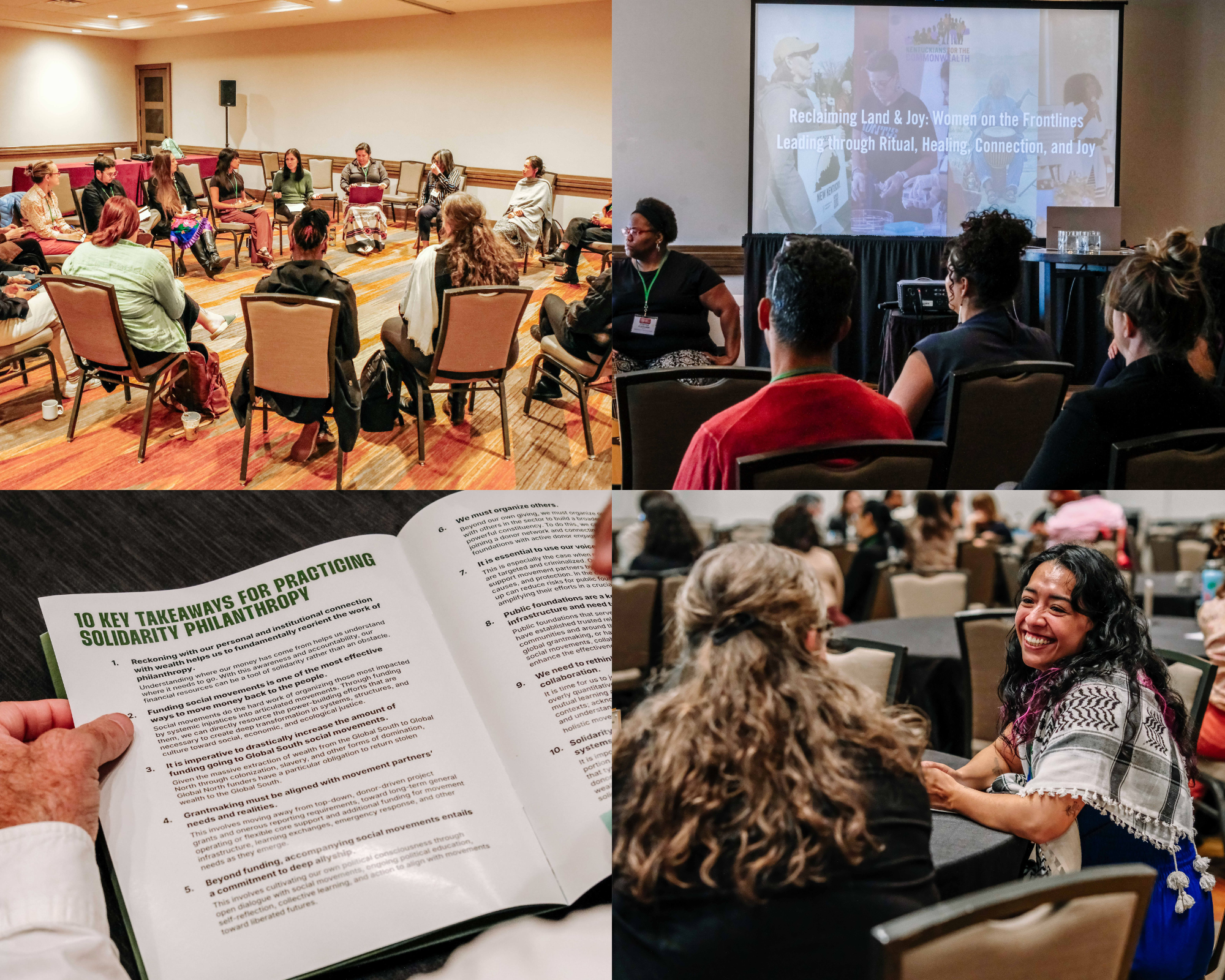
Rooted Giving: Stories Of How Joy, Care, And Imagination Transform Environmental Grantmaking
Arianne Shaffer of the Kindle Project, Hilary Hart of the Kalliopeia Foundation, Pilar Trujillo and Margaret Garcia of the Stars & Seeds Fund, shared an insightful storytelling session that highlighted the impact that place-based grantmaking has on local communities. The Stars and Seeds Fund, is an initiative between the Kindle Project and Kalliopeia Foundation.
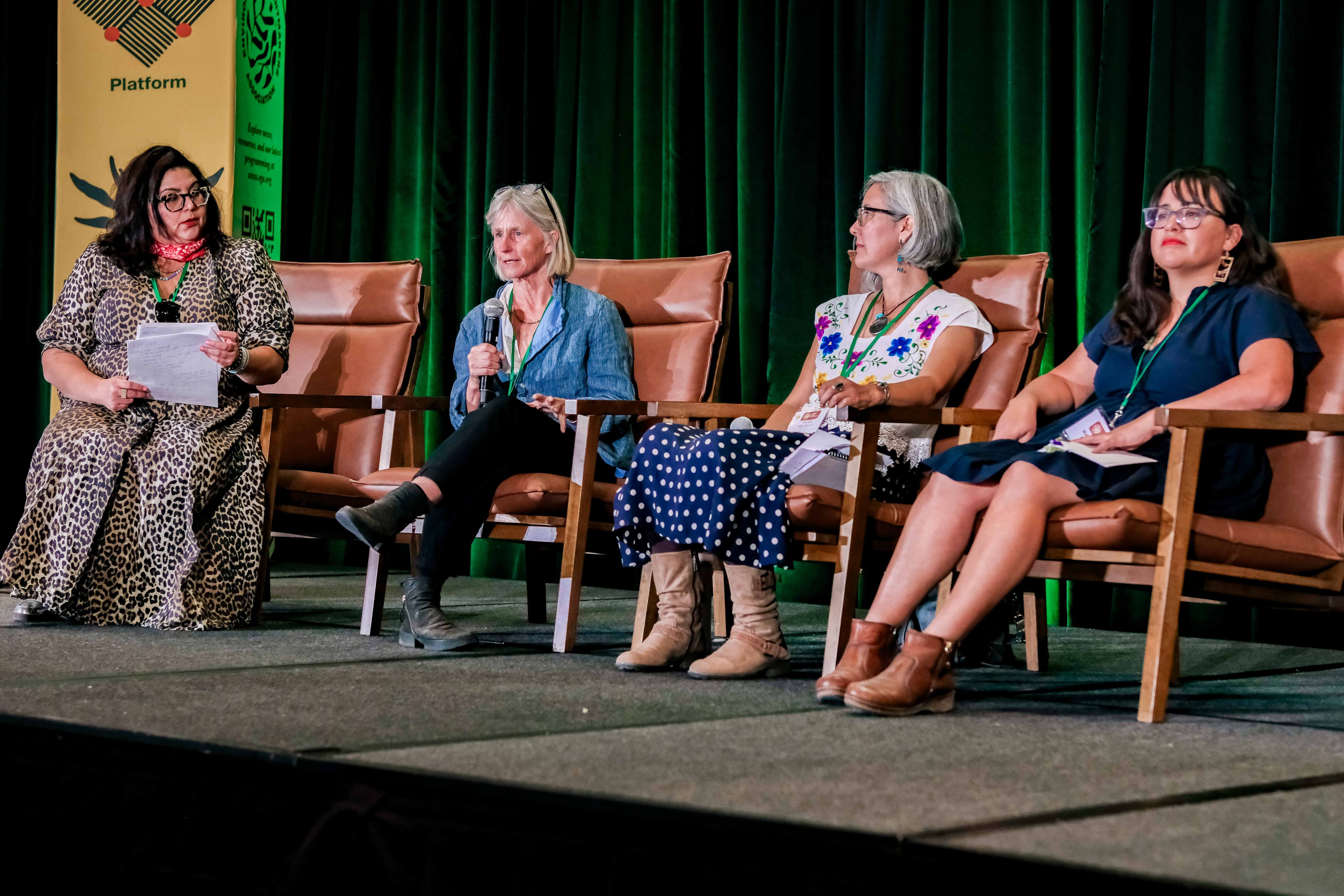
[Left to right: Arianne Shaffer of the Kindle Project, Hilary Hart of the Kalliopeia Foundation, Pilar Trujillo and Margaret Garcia of Stars & Seeds Fund]
The Stars and Seeds Fund utilizes a philanthropic method called “flow funding”, which was originally coined by Marian Rockefeller Weber. Flow funding empowers community experts to make decisions over philanthropic dollars by consensus.
Takeaways
- Flow Funding empowers community solutions: Flow funding is a type of place-based grantmaking that centers community knowledge. It empowers communities to determine for themselves where resources need to go.
- Relationships are critical to impactful grantmaking: We are in relationship with each other and the Earth. Care is the foundation for creativity and innovative thinking.
Lean into innovative ways to connect: Meet in a body of water or another creative location rooted in your work with a facilitator. Then, make sure that you discuss things that you need to talk about in a fun way.
Further Resources:
[Watch] The Story of Flow Funding -Kinship Earth
Native-Led Transformative Grantmaking
Our second plenary discussion featured Jodi Archambault, CEO of Anpo, Inc., Natalie Stites Means, Executive Director of COUP Council, Jade Begay, Co-Founder of Agency and Marian Naranjo, Founder and Director of Honor Our Pueblo Existence (HOPE). Jim Enote, CEO of the Colorado Plateau Foundation moderated the panel.
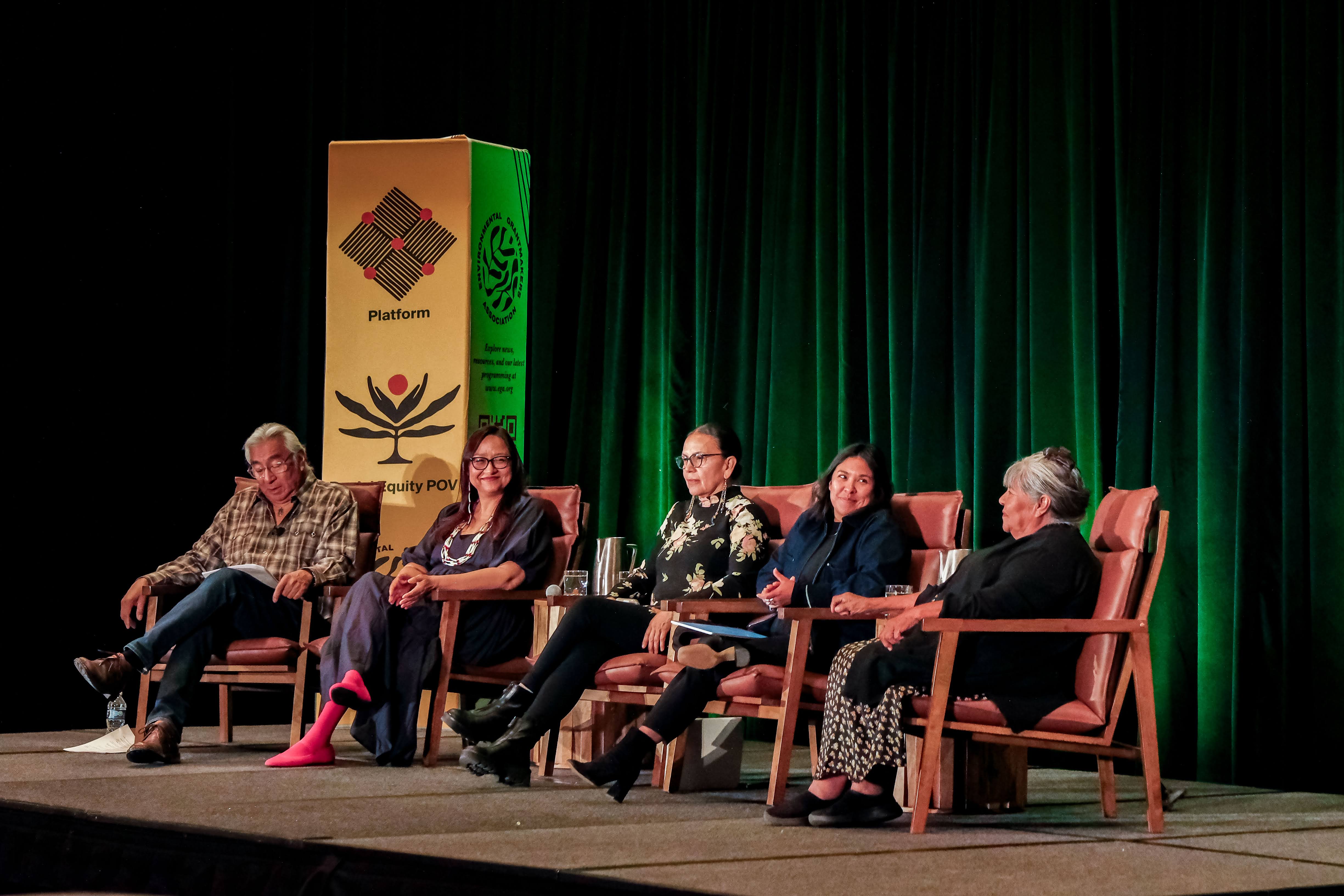
The panelists shared the pivotal moments when they realized that Native leadership had the power to transform systems around them. Panelists outlined ways that philanthropy can support native-led systems of change.
Takeaways
- Changing the narrative on Native knowledge: Native science and technology for managing and stewarding the land are proven strategies that protect biodiversity and bring down emissions.
- Invest in Native leadership and storytelling: Romanticize less about what Indigenous people bring to the table. Invest more into their leadership in movements, restoring Native connections to their land, and ecosystem repair, which have proven effective outcomes.
- From consulting to power-sharing: Transformation requires shifting resources and relationships, narratives, and power. It should not be assumed that Indigenous people would go with all ideas presented. There needs to be dialogue and consent. Justice needs to be a program not a project.
- Dedicate direct investments to Indigenous-led initiatives: A lot of money is going to “Big Greens” with the requirement that they work with Native communities, but oftentimes Native people are still cut out of the decision making. Resources that go directly to Indigenous leaders, or trusted intermediaries and donor-advised funds can better empower and support Indigenous communities.
“Power is most alive when it’s shared, not just bestowed.” - Jim Enote, CEO of the Colorado Plateau Foundation
Further reading:
- [Read] “Pathways Forward 2024 Perspectives from Native Leadership” -Colorado Plateau Foundation
- [Read]: “Treaties Still Matter: The Dakota Access Pipeline” -Native Knowledge 360
- Learn about the National Urban Indian Family Coalition (NUIFC)
- Native Americans in Philanthropy launches Grantwatch, a database dedicated to connecting Tribal Nations and Native communities with grant opportunities.
- “We Live Where We Serve.” A Model of Native-Led Grantmaking on the Colorado Plateau” -Inside Philanthropy
At the Retreat, we deepened our knowledge of the region during immersive pre-institutes and site visits in Santa Ana Pueblo and the surrounding region:

EGA also hosted our second annual Screen on the Green series in partnership with valued member and creative force, The Redford Center. Members watched eight short films spotlighting Indigenous leaders, land defenders, and communities advancing today's climate solutions. The following films were screened at the retreat:
- Demon Mineral
- Drowned Land
- To Use a Mountain
- The Last Floating Garden (El Último Jardín Flotante)
- Bring Them Home
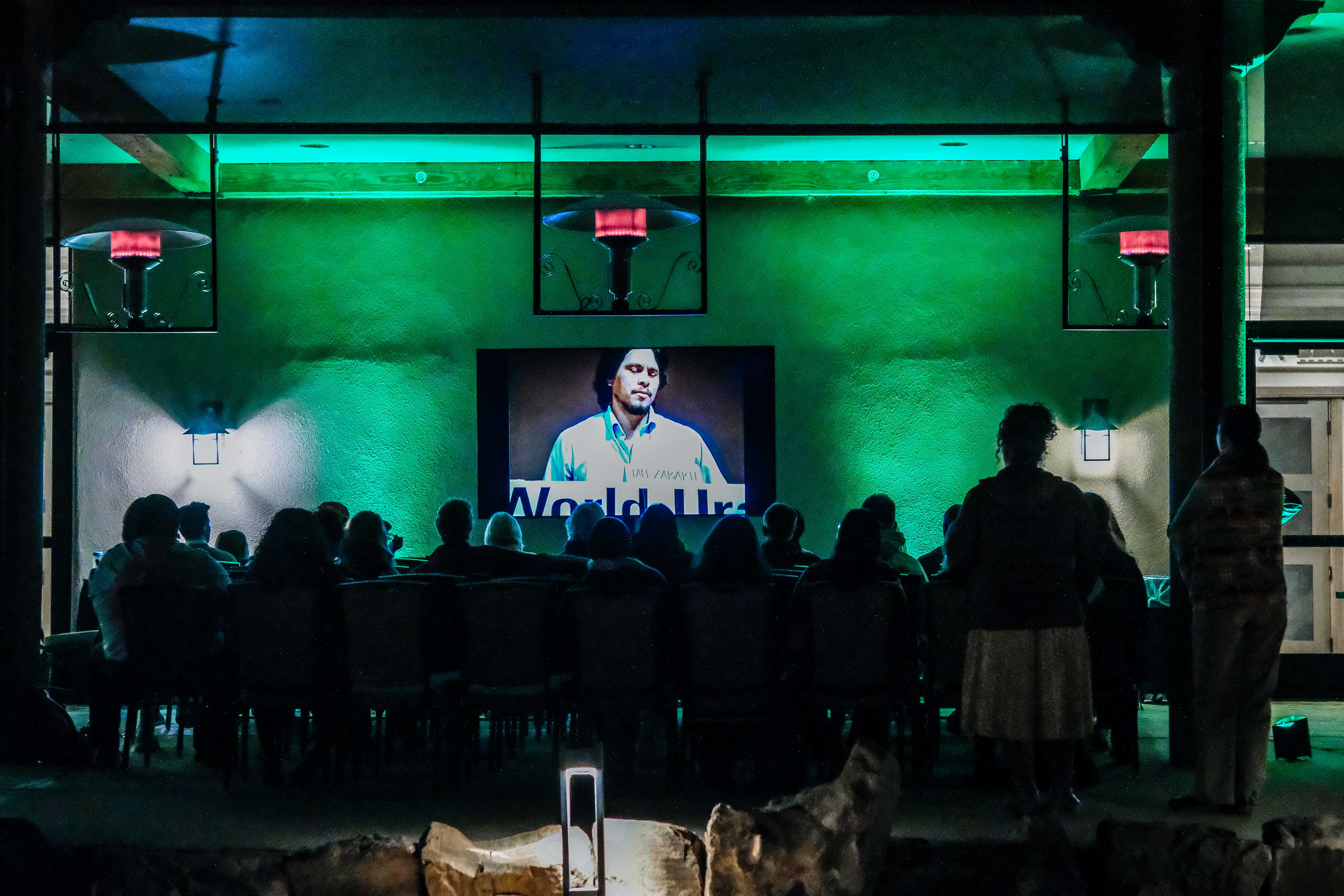
The Redford Center is releasing Drowned Land through its "Films That Move." The film will be available November 13-20. Watch the film here.
Member Themed Dinner Resources
Mitigating the Climate Super Pollutant: Opportunities and Challenges of Reducing Nitrous Oxide Emissions from Fertilizer
Co-sponsored by the McKnight Foundation, this themed dinner explored key findings from a new report on N₂O emissions and highlighted common-sense solutions that center farmers and cross-sector collaboration.
[Read] “Nitrous Oxide – A Hidden Threat”
Reclaiming Resilience: Addressing Conservation Fatigue and Ecological Grief with Courage, Care and Compassion
Co-hosted by the Island Foundation, this themed dinner explored what conservation fatigue and ecological grief is, and the support that can be provided to conservationists to help them manage fatigue. It also provided attendees with a set of mindset shifts required to reimagine what success in conservation looks like.
- [Explore] The First Light Initiative.
- Learn about the Restoring Force Fellowship
- Learn about Movement Education Outdoors
- "Reclaiming Resilience: Addressing Conservation Fatigue and Ecological Grief with Courage, Care and Compassion"- Written by Alice Hotopp (Restoring Force Fellow 2023) and Andrea Bogomolni.
Celebrating Risktaking in Resourcing: The Annual EGA Awards
At the 2025 Fall Retreat, we celebrated the winners of the third annual Donald K. Ross Founders Award and the EGA Risk Taker Awards. These awards honor environmental grantmakers whose dedicated work challenges the status quo. They advance philanthropic impact by shifting power to the people.
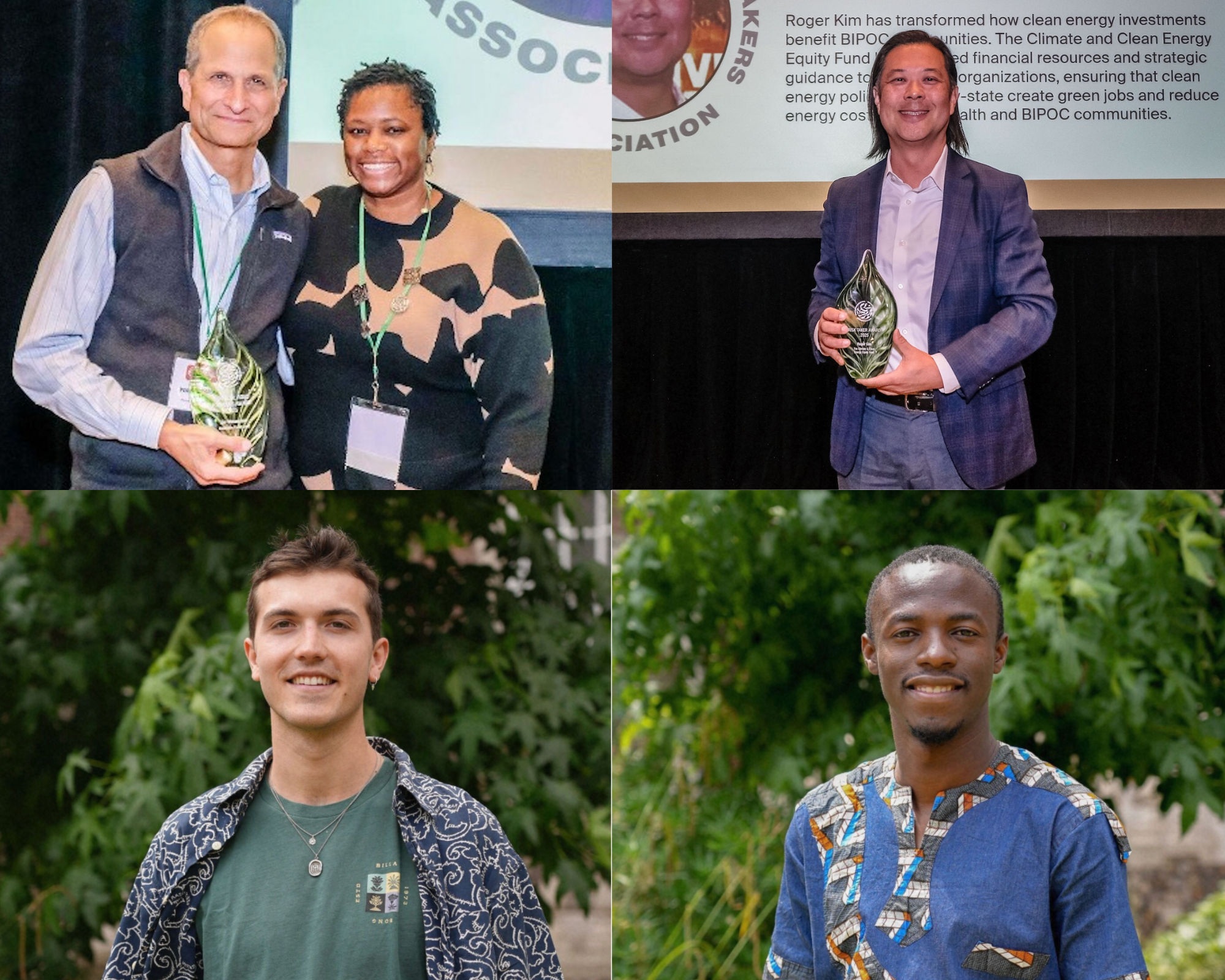
[Top to Bottom]: Lee Wasserman, Director and Secretary of the Rockefeller Family Fund, Roger Kim, Founder and Former CEO, The Climate and Clean Energy Equity Fund, Nathan Méténier and Joshua Amponsem, Co-Directors of the Youth Climate Justice Fund.
Congratulations to the 2025 Honorees!
Donald K. Ross Founders Award Winner: Lee Wasserman, Director and Secretary of the Rockefeller Family Fund.
Risk Taker Award in the category of Visionary/Individual Winner: Roger Kim, Founder and Former CEO, The Climate and Clean Energy Equity Fund
Risk Taker Award in the category of Visionary/Team Winner: Nathan Méténier and Joshua Amponsem, Co-Directors of the Youth Climate Justice Fund.
Learn more about the winners here.
Keynote Closing: A Roadmap to Liberation
We wrapped our Fall Retreat with a thought-provoking keynote from Rev. angel Kyodo williams. Rev. angel is the Founder of Transformative Change. She rejoined us for this year’s Retreat and walked us through the "Roadmap to Liberation," a framework for transformation.
Rev. angel laid the contextual foundations for the Retreat’s culmination and introduction to the Santa Ana Accords. Grantmakers were guided on the value of creating plans situated in truth and culture.
The Framework
- Contemplative Approach: Associated with the element of air, we slow things down enough to create the conditions for the intentions and purposes that we have.
- Embodied Practice: Associated with the element of earth, it is the practice of quieting oneself to heal, while remaining still enough to feel oneself.
- Liberatory Paths: Associated with the element of water, we create the conditions. We move the mainstream to the margins so that the margins are included.
- Prophetic Praxis: Associated with the element of fire, prophetic praxis takes the theory of understanding and telling the truth of these times and puts it into practice.
- Collective Process: Associated with the element of space, it’s the practice of all voices being included at the right place and at the right time.
EGA in Community!
Community, Culture, and Celebration

EGA thanks our Fall Retreat Program Committee Members for their dedication and intentional vision to this year's Fall Retreat!
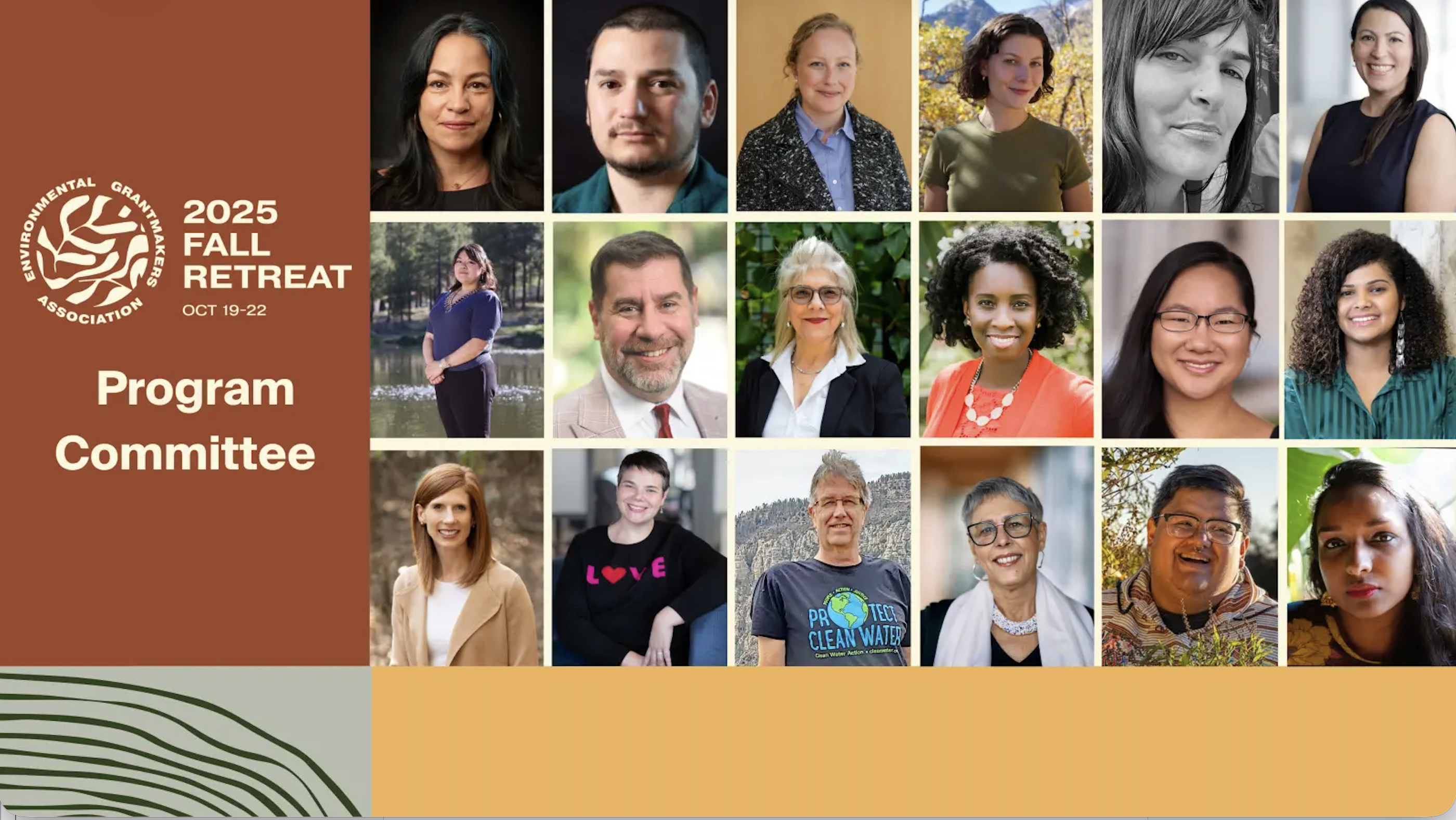
- Retreat Committee Chair: Lourdes J. Rodríguez, DrPH, CEO of the David Rockefeller Fund
- EGA Board Liaison: Louis Gordon, Program Director, Seventh Generation Fund
- Kate Barnes, Senior Program Officer, Climate Solutions, MacArthur Foundation
- Celia Byrne, Program Officer, The Redford Center
- Sadaf Cameron, Co-Founder and Executive Director, Kindle Project
- Nina Carranco, Program Officer, Water Foundation
- Rebekah Chattin, Strategies and Partnerships Associate, Colorado Plateau Foundation
- Arturo Garcia-Costas, Program Director, Regional, National & International Environment, The New York Community Trust
- Frida Hatami, Senior Grants Manager, Roy and Patricia Disney Family Foundation
- Deanna James, President and CEO, St. Croix Foundation for Community Development
- Yeou-Rong Jih, Program Officer, The Kresge Foundation
- Katherine Lorenzo, Program Manager West Campaigns, U.S. Energy Foundation
- Elizabeth Love, CEO, Jacob and Terese Hershey Foundation
- Bethany Maki, Executive Director, Progressive Multiplier Fund
- Jonathan Scott, President and Director, Singing Field Foundation
- Maria Amalia Souza, Founder, Head of Strategic Alliances & Partnerships, Casa Socio-Environmental Fund, Fundo Casa Socioambiental
- Joe Toolan, Justicia Y Equidad Fund Director, GreenLatinos
- Thanu Yakupitiyage, Program Officer, Surdna Foundation

EGA staff thanks you for attending the 2025 Fall Retreat! We look forward to seeing you at our upcoming events and 2026 Fall Retreat. Please save the dates below!
Save the Dates! 📅
2026 Fall Retreat in Virginia Beach, VA
Sept. 27-30, 2026
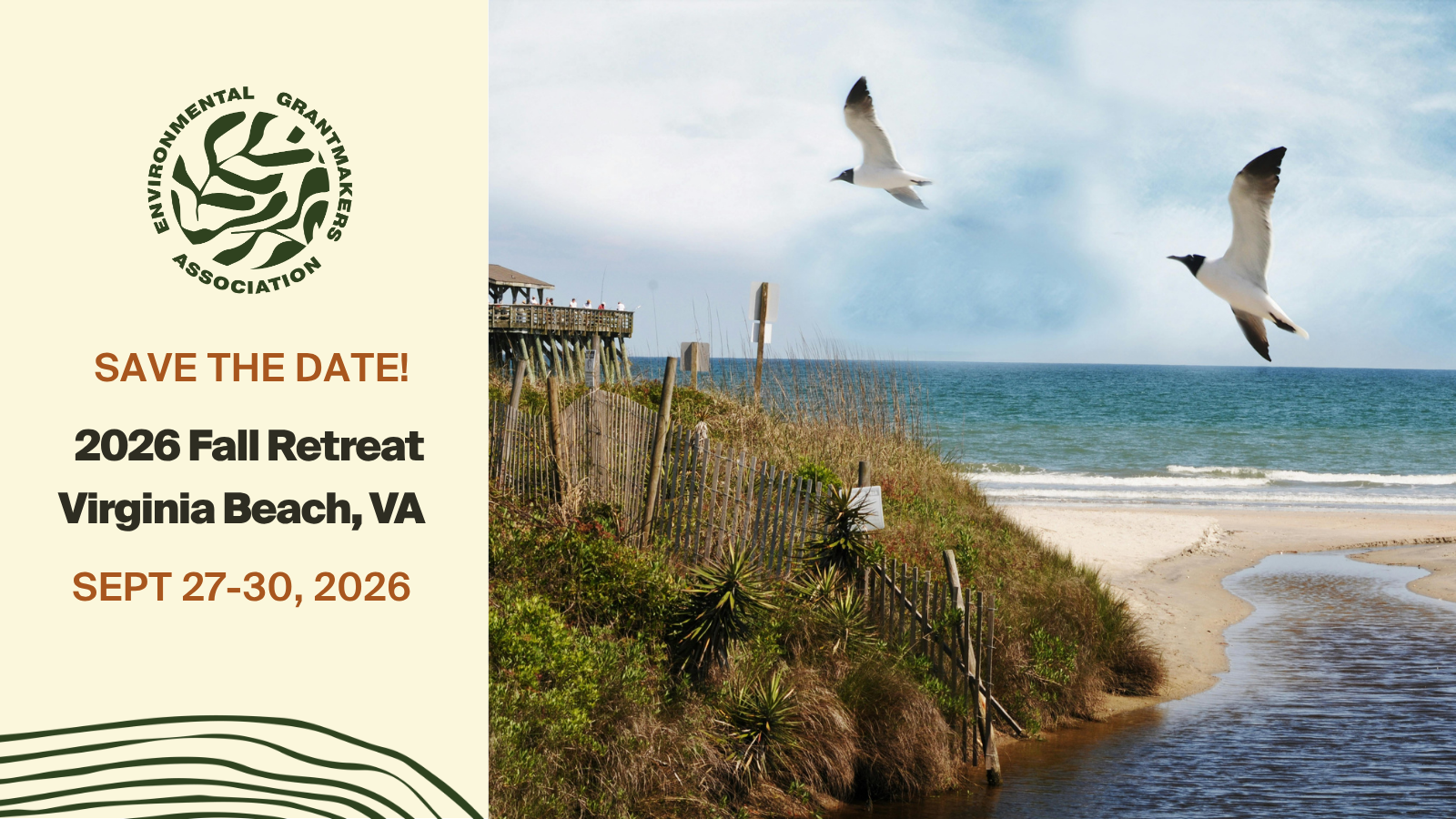
EGA is committed to sustaining an impactful community through innovative programming and philanthropic networks acting in partnership with BIack, Indigenous, People of Color, and marginalized communities as a strategic value. As such, EGA’s programming at the 2025 Fall Retreat was guided by our desire for high-level grantmaking and organizational implementation of our Racial Equity POV.
